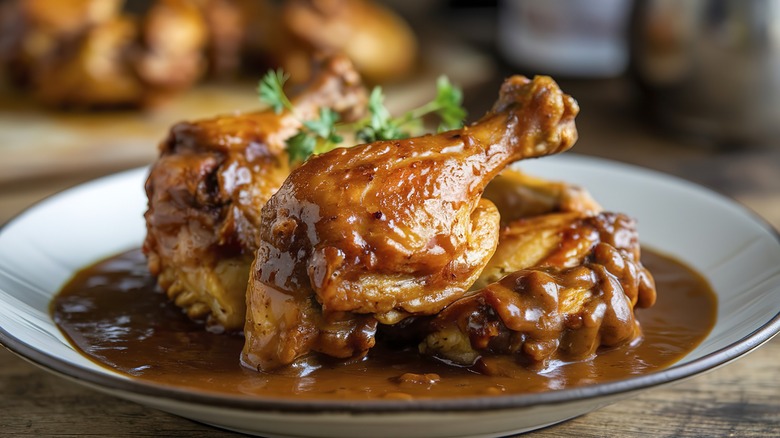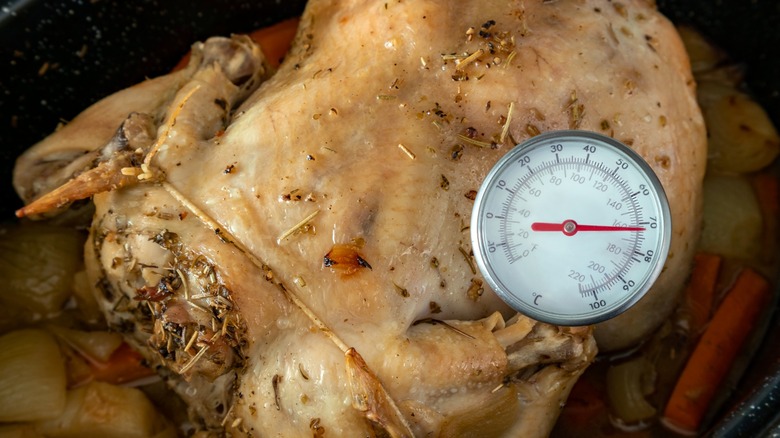The Reasons Chicken Always Tastes So Much Better At Restaurants
We may receive a commission on purchases made from links.
Recreating cuisine I fell in love with at a restaurant always sounds like a good idea, but all too frequently, it ends up lacking the pizzazz of the original. Depending on the dish, there are various reasons why things go south when attempting to mimic restaurant cuisine. Chicken, in particular, seldom comes out as juicy and flavorful as the fare I was served. We contacted a couple of experts to find out exactly why that is, and their insight highlighted some mistakes we've probably all made at some point.
I've often thought that perhaps under-seasoning was my downfall, and according to Kyle Taylor, chef and founder of He Cooks, I was probably right. "Most home cooks underestimate how much seasoning it takes to make chicken pop," he said. So, I'm just not coating the chicken with enough seasoning, right? Not necessarily, according to chef Steve Chiappetti, who oversees culinary operations at both Hotel EMC2 and theWit Hotel, located in downtown Chicago. He said, "Chefs definitely look for bold, memorable flavor — but that doesn't always mean piling on spices."
There is more to seasoning than simply rummaging through your spice rack. "Restaurants rely on brining, marinades, proper searing, and internal temperature checks to keep it juicy and flavorful," Taylor said. "A quick wet brine or marinade, a high-heat sear to lock in juices, and a careful finish at lower heat get you there." (By "there," I assume he means Flavortown.) Some canned ingredients can upgrade chicken, but they are no substitute for a salty brine that simultaneously flavors the poultry and boosts the moisture content, resulting in a juicier bird. Still, there is another reason chicken at home doesn't taste as good as it does at a restaurant, which boils down to an overabundance of caution.
Restaurant-worthy chicken can't be dry
Brining and generous seasoning will augment the flavor of your chicken, but it's all for naught if it dries out. "Home cooks often play it safe and go way past the safe temperature out of fear," Steve Chiappetti said. "Restaurants use thermometers, timing, and technique to hit that perfect internal temp — just 165 degrees Fahrenheit — without crossing into dry territory." A digital reader like the Alpha Grillers Meat Thermometer will give you an accurate temperature reading (Checking the color isn't a reliable way to check the doneness because, in some scenarios, you can actually eat pink chicken). But, regarding timing and technique, one mistake many folks make is not remembering to let your cooked chicken rest.
Poultry will continue to cook after being removed from the heat. Depending on the size of the chicken, pulling it when it reaches between 155 and 160 degrees Fahrenheit will allow it to reach a food safe 165 degrees Fahrenheit after resting for a few minutes. As Kyle Taylor said, "Moisture retention comes from control, not guesswork." It might take some practice to ascertain the exact moment when meat should start resting, but once you've nailed it, you will never have to guess again.
Of course, when cooking something like a chicken burger, which has a notorious reputation for being dry and lacking in flavor, you need to pull out all the stops. "Restaurants often layer flavor with marinades, rubs, searing, glazes, or sauces," Taylor said. Chiappetti, however, takes a more delicate approach to make the burger both moist and flavorful. "I lean into the natural flavor of great chicken and use light, clean seasoning to enhance it, not mask it," he said. "A flavored mayo or aioli on the finished burger can take it over the top without needing to overload the patty itself."

